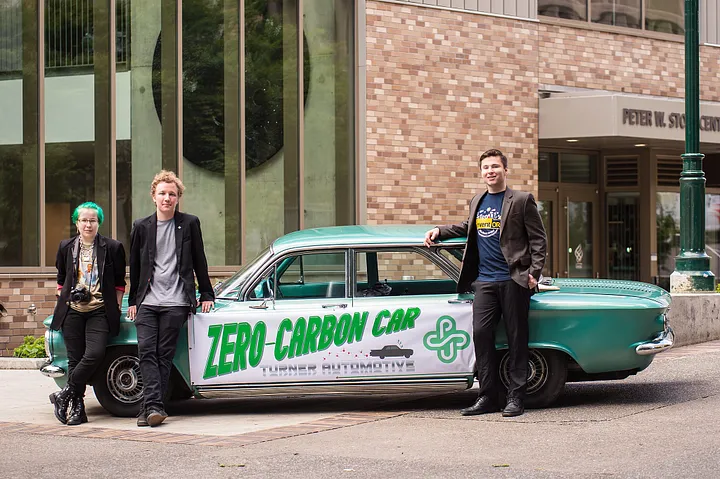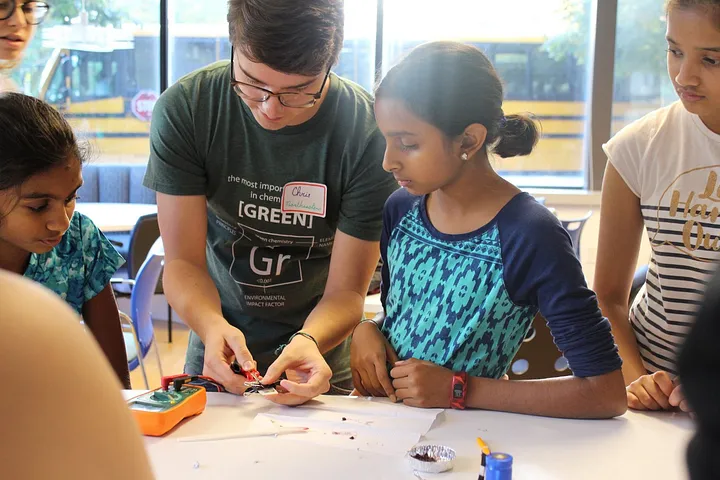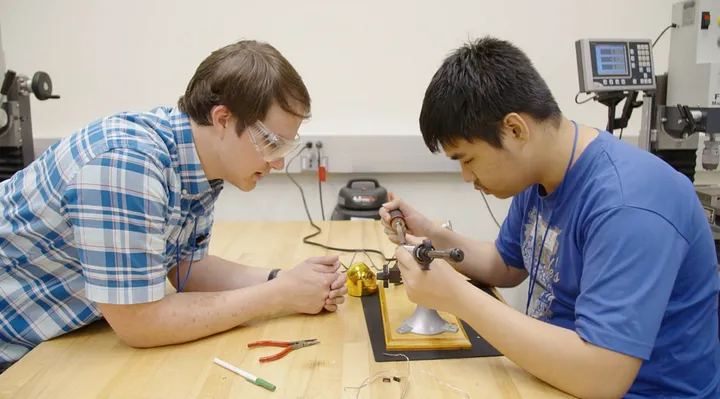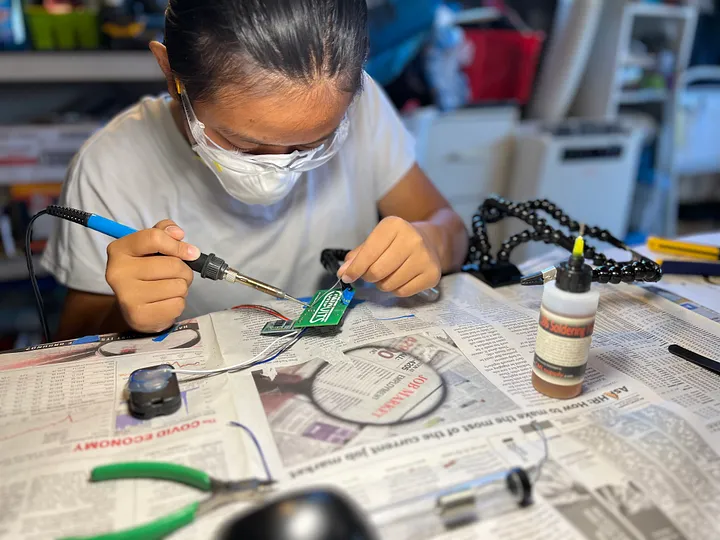Middle school inventor Jeanelle Dao with her prototype of a pattern-sensing doormat to allow people with hand disabilities to unlock doors with a tap of the foot. (Courtesy of Society for Science)
Rethinking Education for a World Fueled by Creativity and Innovation
By Rob Schneider, Executive Director of The Lemelson Foundation and David Coronado, Senior Program Officer
Fresh off this year’s InventEd Convening, we’re reminded of the importance and promise of invention education. The 2024 convening brought together a vibrant community of educators, administrators, researchers, government agencies, corporations, and other invention education stakeholders who are all dedicated to fostering the inventive mindset in our youth. The event served as a valuable platform to share crucial lessons learned in equipping students with the skills they need to become the inventors and problem-solvers of tomorrow. These insights solidify the importance of integrating invention education directly into school curriculums. By nurturing creativity and innovation in the classroom, we empower students to not just adapt to a changing world, but actively shape it through their ideas and ingenuity.
Just imagine: the air crackles with the energy of invention. In a loud and bustling classroom, a young girl hunches over her desk, intent to solve for a neighborhood cleanup problem with the precision of a seasoned tech engineer. Her eyes dance with the thrill of discovery as she brings her gamified and environmentally-focused pollution cleanup app to life with the encouragement of an inspirational educator.
In another classroom across the country, a curious middle school boy dives into the realm of renewable energy, his vision finally settling on the intriguing possibilities of triboelectricity. Excitement electrifies the room as he unveils his invention: the triboelectric nanogenerator.
In a college conference room, a team of students combine engineering prowess and entrepreneurial skills — and a love of classic cars — to create a start-up company that converts old gas-guzzlers to run on climate-friendly hydrogen.

These stories — and so many more — are testament to the power of invention education. These classrooms are a launchpad for a future America that is built on ingenuity, innovation, and a relentless drive to solve the world’s most pressing problems.
Think of the challenges that loom on the horizon: the climate emergency, resource scarcity, pandemics, and the ever-evolving landscape of jobs and technologies. These are not problems that single disciplines can tackle in isolation. They demand a collaborative mindset, an ensemble of voices in the pursuit of solutions that transcend traditional boundaries. That’s where invention education excels, removing the walls between science, technology, engineering, math, and the humanities, and infusing real-world knowledge that equips students with the tools to think critically, collaborate effectively, and innovate across disciplines.
Invention education also adds a vital spark, igniting the fire of creativity and agency in young minds. It equips students to find problems and invent solutions for their unwritten future — teaching them not just to learn, but to create, to dream up solutions that dance on the edge of possibility. Students become tinkerers, inventors, problem-solvers — molding the future with every line of code, every twist of a wrench, every leap of imagination.

Investing in this potent combination isn’t just about nurturing young minds; it’s about building a nation that thrives for everyone in the 21st century. The economic landscape is shifting, demanding a workforce equipped not just with technical skills, but with the adaptability, the resourcefulness, and the entrepreneurial spirit that comes from learning to think and create across disciplines. These graduates won’t just fill open positions; they’ll create new ones, driving innovation in fields we haven’t even imagined yet.
Why is this crucial? Because the future doesn’t just arrive, it’s built by people. And the American Dream can’t survive on fading echoes of past triumphs or rely on our current education practices. Let’s build innovative and equitable education programs in K-12 and higher education across the country where diverse perspectives coalesce and unconventional ideas ignite change. This cross-pollination of different fields, diverse perspectives, and unfettered inventiveness holds the key to unlocking equitable economic dynamism beyond the reach of traditional, compartmentalized education.
In a world where innovation is currency, America risks being left behind if we cling to the comfort of siloed disciplines and a focus on memorization and rote learning, instead of building inventive mindsets. Invention education is a passport to a future where American ingenuity isn’t just a relic of the past, but a beacon for the world, attracting the brightest diverse minds and fostering collaboration beyond borders.
Think of the possibilities:
- a middle-schooler combining A.I. with satellite imagery from NASA and NOAA to predict potential wildfire hotspots and detect active fires;
- a high-schooler developing low-cost, infection-sensing stitches that could transform health care in underserved communities;
- and a college student improving the resolution of electron microscopes that can help scientists build new materials for everything from cleaner energy to better drug delivery in the body.
These ideas were all nurtured by innovative educators and mentors who ignited curiosity and inventiveness in their classrooms. But with invention education, not every student is expected to become an inventor or pursue a STEM field. It develops the inventive mindsets and problem-solving skill sets that our youth will need in a rapidly changing workforce and world.
The benefits extend far beyond the economic realm. Invention education empowers students to become active citizens, not just consumers of technology. They learn to understand our interconnectedness, to see how their actions ripple through ecosystems, communities, and even across the globe. This fosters a sense of responsibility that fuels progress and drives positive change.

Let’s invest in innovating our education system. Let’s equip every K-12 and higher education classroom with experienced educators who have the tools and the spirit of invention. Let’s remove the barriers between disciplines and unleash the boundless potential of young minds. Let’s build a future where America isn’t just a nation of consumers, but a nation of diverse creators and problem-solvers.
Because this is not just an investment in education; it’s an investment in the people who drive our future. It’s about securing our nation’s economic prosperity, building a sustainable planet, and nurturing a generation of responsible citizens who will lead us into the next chapter of human history.

To learn more, check out these resources on invention education:

